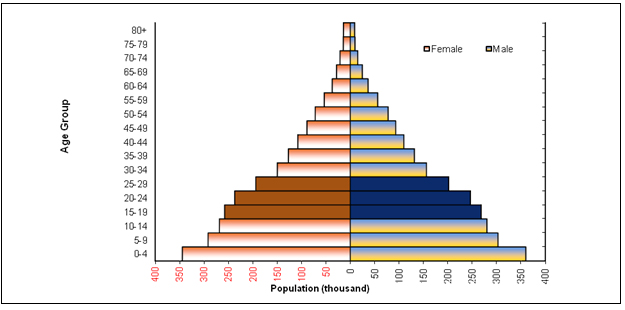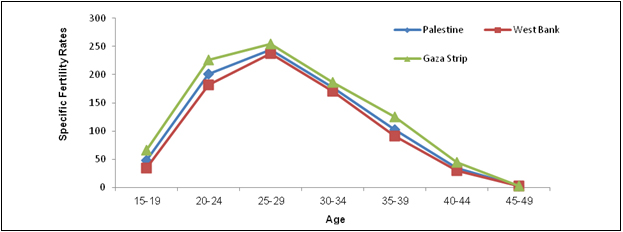Palestinian Central Bureau of Statistics (PCBS)
On the Eve of International Youth Day 12/8/2015
On the eve of International Youth Day, the PCBS releases a statistical review on the status of Palestinian youth:
Youth comprises one third of Palestinian Society
The percentage of Youth represents 30.0% of the total population in Palestine: 37.4% of them are adolescents aged (15-19) years and 62.6% are youth aged (20-29) years. The sex ratio among youth is 104.1 males per 100 females, while the estimated population in Palestine totaled 4.68 million in mid-2015.
Population Pyramid in Palestine, Mid-2015

Marriage and divorce rates higher among females aged (15-29)
The number of registered marriages in Shariah courts and churches of 2014 in Palestine 43,732 contracts, with acrude marriage rate 9.6 per 1000 population, and the data also indicate that 92.2% of females were in the age group of (15-29) years are married compared to 80.8% of males. On the other hand the number of registered divorce in Shariah courts of 2014 in Palestine 7,603 cases, with acrude divorce rate 1.7 per 1000 population, and the data also indicate that 77.2% of divorced females were aged between (15-29) years compared with 55.4% for divorced males.
Females aged (25-29) years represent the highest contributor of total fertility rate among all ages groups
According to the final results of the Multiple Indicator Cluster Survey 2014, the total fertility rate in Palestine declined to 4.1 births between (2011-2013) compared to 4.4 births in 2010. At the region level, the total fertility rate in the West Bank between (2011-2013) was 3.7 birth compared with 4.5 birth in Gaza Strip. Females aged (25-29) years contribute 30.1% of the total fertility rate, the highest contributor of all age groups.
Age-Specific Fertility Rates by Region, 2011-2013

39.8% of youth (15-29) years were enrolled in education in 2014
In 2014, 39.8% of youth aged (15-29) years were enrolled in education; 83.5% in the age group of (15-17) years, 45.5% in the age group of (18-22) years, and 10.0% in the age group of (23-29) years. Dropout rates (who left the education before complete the educational stage who attended) were 33.6%; 39.9% for males and 27.2% for females. Moreover, dropout rate in secondary stage in 2013-2014 among the youth (15-29) years in Palestine reached 3.7% (4.2% for males, 3.3% for females).
Young female more enrollment at higher education than young males
In addition, 9.2% of males aged (15-29) years hold a university degree and above compared to 13.1% of females in the same age group. A further 3.2% of males had not completed any educational stage compared to 1.6% of females in the age group of (15-29) years. Furthermore, 0.7% of youth aged (15-29) years are illiterate.
More than 3 quarters of youth do not read newspapers and magazines
In 2014, 75.5% of youth aged (15-29) years in Palestine don’t read newspapers or magazines at all; 74.6% in the West Bank and 77.0% in Gaza Strip. Also, 93.7% of youth in Palestine watch television on a daily basis compared to 23.9% who listen to the radio daily.
About three in every 100 youth suffered from one chronic disease at least
Prevalence of chronic diseases among youth aged (15-29) years
by sex and region, 2010
|
Sex |
Palestine |
West Bank |
Gaza Strip |
|
Both sexes |
2.5 |
2.7 |
2.2 |
|
Males |
2.8 |
3.0 |
2.4 |
|
Females |
2.1 |
2.3 |
1.9 |
More than one quarter of Male youth smoke
Prevalence of smoking among youth aged (15-29) years
by sex and region, 2010
|
Sex |
Palestine |
West Bank |
Gaza Strip |
|
Both sexes |
15.1 |
19.8 |
7.3 |
|
Males |
28.7 |
37.4 |
14.3 |
|
Females |
0.9 |
1.4 |
0.1 |
Females more vulnerable to violence
Data of the violence survey in Palestinian society 2011 indicated that 20.8% of the youth were vulnerable to one type of violence at the least (19.4% for males against 22.1% for females).
31.4% of the youth who were vulnerable to psychiatric violence, and 39.1% were vulnerable to physical violence while 1.1% of them were vulnerable to sexual violence.
About 4 in every 10 of youth unemployed during the 2nd quarter 2015
The data of labor force survey for the 2nd quarter of 2015 showed that 40.7% of youth aged (15-29) years are economically active (employed and unemployed); 41.1% in the West Bank and 40.1% in Gaza Strip. The youth unemployment rate totaled in Palestine at 37.4%. The highest unemployment rate was 41.7% in the age group of (20-24) years compared with 35.6% for the age group of (25-29) years and 31.6% for the age group (15-19) years. In addition, 46.9% of those unemployed had completed at least 13 schooling. While the unemployment rate among youth graduates was 52.0% in the 2nd quarter of 2015.
More than a quarter of youth in Palestine suffered from poverty during the year of 2011
The relative poverty line and the deep poverty line according to consumption patterns (for reference household consisted of 2 adults and 3 children) in Palestine in 2011 were 2,293 NIS, and 1,832 NIS respectively. The poverty rate among Palestinian individuals was 25.8 (17.8% in the West Bank, and 38.8% in Gaza Strip). 12.9% of the individuals in Palestine were suffering from deep poverty in 2011 according to consumption patterns (7.8% in the West Bank, and 21.1% in Gaza Strip). While 27.4% of youth (15-29) years are under the poverty rate (19.2% in the West Bank and 40.9% in Gaza Strip).
Males youth spend more time in community services work while females spend more time in domestic work
Time use data 2012/2013 indicated that person in age (15-29) years spend around of 2 hours and 41 minutes in non-payed domestic work during the day, 3 hours and 20 minutes for females and one hour and 8 minutes for males. Females spend 53 minutes on shopping compared to 44 minutes for males. Males youth spend 2 hours and 12 minutes on visiting cultured and entertainment places compared to 3 hours and 20 minutes for females.
Data also showed that youth aged (15-29) years spend around 44 minutes during the day on reading; )44 minutes for females and 47 minutes for males( compared to 51 minutes ) 49 minutes for females against 54 minutes for males( according to results time use survey 1999/2000. While females spend more time on watching T.V. compared to males (2 hours and 26 minutes compared to 2 hours and 9 minutes respectively), in comparison 2 hours and 40 minutes against 2 hours and 15 minutes respectively according to results time use survey 1999/2000. Also males youth spend more time listening to radio; around one hour and 23 minutes compared to 45 minutes for females, in comparison to 55 minutes for males against 51 minutes for females according to results time use survey 1999/2000.
One the other hand, the males youth spend around one hour and 32 minutes in and assisting other families (Volunteers Activities), in comparison to 2 hours and 26 minutes according to results time use survey 1999/2000. While females spent 45 minutes in comparison to one hour and 41 minutes according to results time use survey 1999/2000.
 عربي
عربي